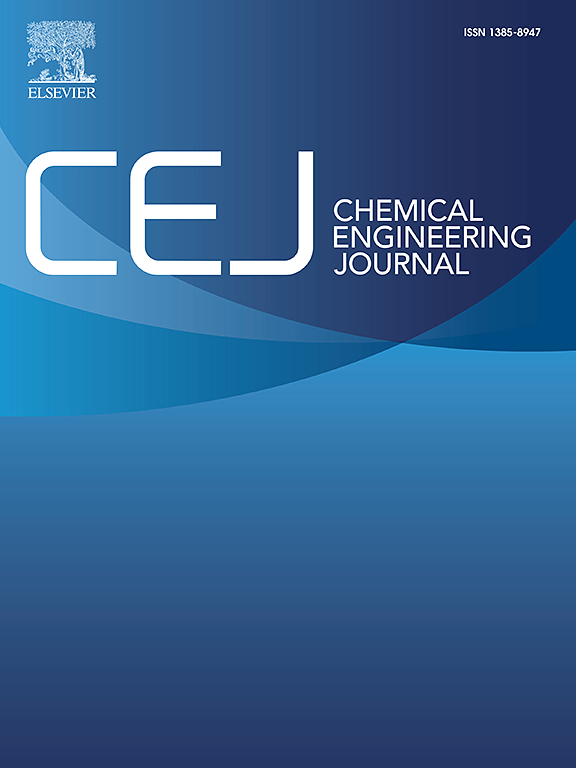Facilitating extensive CC bond cleavage in lignin models through customized CeO2/C3N4 S-scheme heterojunction
IF 13.2
1区 工程技术
Q1 ENGINEERING, CHEMICAL
引用次数: 0
Abstract
Photocatalytic depolymerization of lignin offers a sustainable approach to producing high-value-added aromatic compounds. Recently, carbon nitride has demonstrated notable selectivity for the C C bonds in lignin model compounds. However, limitations of pure carbon nitride include the low mobility of photogenerated electrons and the difficulty in precisely controlling the cleavage pathways and products of C
C bonds in lignin model compounds. However, limitations of pure carbon nitride include the low mobility of photogenerated electrons and the difficulty in precisely controlling the cleavage pathways and products of C C bonds. In this study, we constructed an S-Scheme heterojunction by in situ loading of Ce ions onto C3N4 to form a CeO2/C3N4 composite. This heterojunction achieves efficient lignin depolymerization under blue LED irradiation in an oxygen-rich environment. Comparative analysis indicated that the yield of primary products, benzaldehyde and phenyl formate, increased by 7.8-fold and 7.75-fold, respectively, compared with pure CeO2, and by 1.4 and 1.8 times relative to unmodified C3N4. After optimizing the reaction conditions, dealkalized lignin is applied to the system and successfully depolymerized. Comprehensive characterization and theoretical simulations verify the heterojunction's ability to enhance carrier separation and redox activity, with CeO2 serving as an active dehydrogenation site that significantly boosts the depolymerization efficiency of lignin model compounds. This photocatalytic strategy presents a valuable step forward in lignin valorization and supports the sustainable utilization of biomass resources.
C bonds. In this study, we constructed an S-Scheme heterojunction by in situ loading of Ce ions onto C3N4 to form a CeO2/C3N4 composite. This heterojunction achieves efficient lignin depolymerization under blue LED irradiation in an oxygen-rich environment. Comparative analysis indicated that the yield of primary products, benzaldehyde and phenyl formate, increased by 7.8-fold and 7.75-fold, respectively, compared with pure CeO2, and by 1.4 and 1.8 times relative to unmodified C3N4. After optimizing the reaction conditions, dealkalized lignin is applied to the system and successfully depolymerized. Comprehensive characterization and theoretical simulations verify the heterojunction's ability to enhance carrier separation and redox activity, with CeO2 serving as an active dehydrogenation site that significantly boosts the depolymerization efficiency of lignin model compounds. This photocatalytic strategy presents a valuable step forward in lignin valorization and supports the sustainable utilization of biomass resources.

通过定制的CeO2/C3N4 S-scheme异质结,促进木质素模型中广泛的CC键裂解
木质素光催化解聚为生产高附加值芳香族化合物提供了一条可持续发展的途径。近年来,氮化碳在木质素模型化合物中对CC键表现出了显著的选择性。然而,纯氮化碳的局限性包括光生电子的低迁移率以及难以精确控制CC键的裂解途径和产物。在本研究中,我们通过在C3N4上原位加载Ce离子来构建S-Scheme异质结,形成CeO2/C3N4复合材料。这种异质结在富氧环境下的蓝光LED照射下实现了高效的木质素解聚。对比分析表明,初级产物苯甲醛和甲酸苯酯的产率分别比纯CeO2提高了7.8倍和7.75倍,比未改性的C3N4提高了1.4倍和1.8倍。优化反应条件后,将脱钾木质素应用于该体系,并成功解聚。综合表征和理论模拟验证了异质结增强载体分离和氧化还原活性的能力,CeO2作为活性脱氢位点,显著提高了木质素模型化合物的解聚效率。这种光催化策略为木质素增值提供了有价值的一步,并支持生物质资源的可持续利用。
本文章由计算机程序翻译,如有差异,请以英文原文为准。
求助全文
约1分钟内获得全文
求助全文
来源期刊

Chemical Engineering Journal
工程技术-工程:化工
CiteScore
21.70
自引率
9.30%
发文量
6781
审稿时长
2.4 months
期刊介绍:
The Chemical Engineering Journal is an international research journal that invites contributions of original and novel fundamental research. It aims to provide an international platform for presenting original fundamental research, interpretative reviews, and discussions on new developments in chemical engineering. The journal welcomes papers that describe novel theory and its practical application, as well as those that demonstrate the transfer of techniques from other disciplines. It also welcomes reports on carefully conducted experimental work that is soundly interpreted. The main focus of the journal is on original and rigorous research results that have broad significance. The Catalysis section within the Chemical Engineering Journal focuses specifically on Experimental and Theoretical studies in the fields of heterogeneous catalysis, molecular catalysis, and biocatalysis. These studies have industrial impact on various sectors such as chemicals, energy, materials, foods, healthcare, and environmental protection.
 求助内容:
求助内容: 应助结果提醒方式:
应助结果提醒方式:


